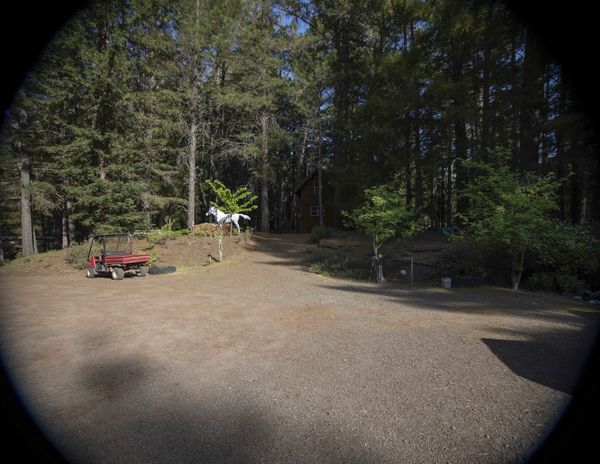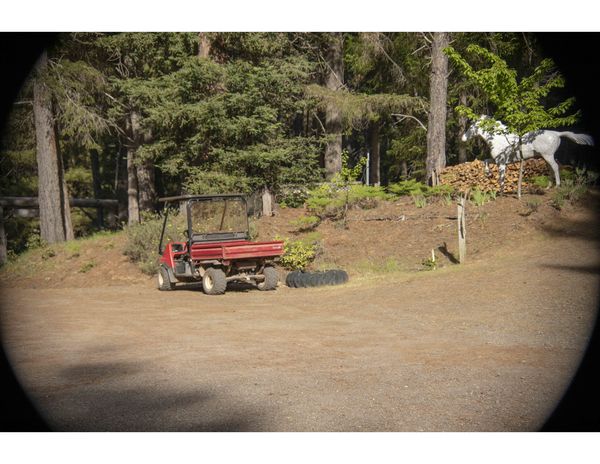Tamron
May 9, 2019 13:00:05 #
You are trying to compare apples to oranges!
The Tamron 90 mm macro is a special purpose lens well suited to macro and portrait photography.
The 18-400 is a generic all purpose jack of all trades master of none lens and as previously mentioned a design that comes with a lot of compromises. I personally think it is of counter intuitive to mount a lens like this on an interchangeable lens camera. If you consider a lens like this you would be better off just to buy one of those super zoom cameras and be done with it.
The Tamron 90 mm macro is a special purpose lens well suited to macro and portrait photography.
The 18-400 is a generic all purpose jack of all trades master of none lens and as previously mentioned a design that comes with a lot of compromises. I personally think it is of counter intuitive to mount a lens like this on an interchangeable lens camera. If you consider a lens like this you would be better off just to buy one of those super zoom cameras and be done with it.
May 9, 2019 17:49:53 #
amfoto1
Loc: San Jose, Calif. USA
kcj wrote:
Looking to buy the Tamron 90 mm macro it is. Suppose to be a great lens now Tamron has the 18 to 400 mm lens that is not a macro, but still has good macro capabilities .does anyone have this lens ? How is it for a all around lens? How is the weight?
The 18-400mm is only able to do 0.344X magnification.... approx. 1/3 life size or 1:3.
The Tamron 90mm macro lenses are capable of 1:1 or 1.0X magnification.... full life size.... or about three times the magnification of the zoom lens.
The 90mm macro lenses are well regarded with a long history and are sharper, too. They're probably "flat field" designs (most macro lenses are), which will render sharper corners than an "all purpose" lens that's not specifically designed for macro work. Basically what this means is that the macro lens is optimized for close up work, under two feet from the film/sensor plane of the camera. Lenses that aren't designed for macro work tend to be optimized for 8, 10, 12 feet or more.
The 90mm macros are also "faster"... They're f/2.8 lenses, instead of the f/3.5-6.3 of the zoom. You might note that there's only 2/3 stop difference between f/2.8 and f/3.5... however, that's only at the 18mm setting and the zoom's variable aperture stops down very quickly as you adjust it to longer focal lengths. At 27mm it's f/4... at 50mm it's f/4.5.... etc. In fact, by 90mm it's f/5.6 or two full stops dimmer than either of the 90mm macro lenses. It's another 1/3 stop dimmer from around 117mm onward. The 18-400mm gives the highest magnification at 400mm, where it's f/6.3.
Unfortunately, a lot of zooms get labelled "Macro", even though they really aren't, by most peoples' definition. It's a common marketing ploy. There is no strict definition of what constitutes "macro". Some say a lens must be able to do full life size, in order to be considered macro capable. Others... often old farts like me... consider 1:2 or half life size as the cut-off. This was common among older macro lenses, many of which could only do that much magnification on their own and required some sort of adapter or extension to reach full 1:1.
Either way, the 18-400mm zoom falls short, with only 1/3 life size. However, to be fair, that's actually pretty good for a zoom. Many zooms that claim macro capabilities actually come nowhere close that high magnification... I've seen lenses with 0.25X (1/4 life size), 0.20X (1/5 life size) or even less called "macro".
One of the highest magnification zooms is Canon's EF 24-70mm f/4L IS USM, which can do 0.70X or nearly 3/4 life size, all on it's own.
FYI: "Life size" refers to the subject size in relation to the film or sensor of the camera. For example... 1:1, 1.0X or full life size on a full frame camera means that the lens has enough magnification and can focus close enough for an image that covers a 24x36mm area (for reference, a U.S. quarter is 25mm in diameter, so it would fill the image area of a full frame camera at full 1:1 magnification). On a so-called APS-C or "crop sensor" camera, the sensor is smaller, roughly 15x23mm, which would be what's captured "at full 1:1".
To put this in perspective, at 1:2 or half life size, the full frame image would capture an area 48x72mm... or the APS-C camera would capture 30x46mm. At 1:4 or one fourth life size, they would capture 96x144mm and 60x92mm, respectively.
There are actually two Tamron SP 90mm macro lenses available in some mounts. There is one that's "IF" or "internal focusing" (doesn't increase in length when focused closer), has image stabilization (Tamron calls it "VC" or "vibration control") AND has faster USD autofocus (ultrasonic motor). That lens typically sells for about $650. The other Tamron SP 90mm is not IF, doesn't have VC and uses a slower micro motor form of autofocus drive. It usually costs about $500.
Another key difference between the zoom and either of the macro lenses would become apparent during manual focusing, which is often desirable when shooting macro. The 18-400mm's manual focus is "short throw", designed for speed, with less concern about accuracy. It goes from closest focus to infinity with less than 60 degree rotation of the lens' focus ring. It's the exact opposite with the macro lenses... like most of those, the Tamron 90mm lenses use a "long throw" focus design, which emphasizes accuracy over speed. The VC/USD version has almost 210 degree rotation, going from closest possible focus to infinity.
Both the Tamron 90mm lenses are full frame capable, so will work fine on either a full frame camera or a crop sensor DSLR. The 18-400mm is a crop-only lens, cannot be used on
If you're interest is shooting macro, get one of the Tamron 90mm and have fun. I have little doubt that either of them will out-perform the 18-400mm for this purpose.
To be fair, the 18-400mm is surprisingly good, for lenses of that type. It has better image quality than most "do it all" zooms. However, all lenses of that type have to compromise in a lot of ways. And the 90mm macro lenses are considerably sharper. See for yourself the difference in the magnified test shots at the link below. I set the zoom to 100mm, as similar as possible to the focal length of the macro lenses (but to get it's highest degree or magnification - 0.344X - you'd need to use it at 400mm). I also stopped the 90mm lens down to f/5.6, the same aperture as the zoom lens' maximum at 100mm. (Note: Test shots were done with a Canon 7D Mk II camera, but that doesn't matter so long as both lenses are tested on the same camera)...
https://www.the-digital-picture.com/Reviews/ISO-12233-Sample-Crops.aspx?Lens=1046&Camera=963&Sample=0&FLI=0&API=3&LensComp=1145&CameraComp=963&SampleComp=0&FLIComp=2&APIComp=1
Finally the zoom is slightly heavier and a little larger. It's only around 1/4 lb. heavier. And when the zoom is set to the widest, they aren't much different in size, either. However, at the 400mm setting it's considerably longer. This can be a consideration because "minimum focus distance" (MFD) is measured from the film/sensor plane of the camera to the subject, so part of the camera and the lens itself occupy part of that space. The 90mm (IF model) on a typical camera total about 6.25" out of the approx. 12" MFD... so there's about 6" of working distance between the lens (without hood installed) and the subject at full 1:1. In contrast, the 18-400mm grows quite a bit longer at 400mm and with the camera totals about 10.5" of the approx. 17.5" of MFD... leaving about 7" of working distance between the lens (w/o hood) and the subject. That's very similar.... HOWEVER, the 18-400mm is only rendering 1:3 at it's MFD... one third as much magnification as the macro lens.
More complete specifications of both can be compared here:
https://www.the-digital-picture.com/Reviews/Lens-Specifications.aspx?Lens=1145&LensComp=959
Detailed reviews can be found here:
https://www.the-digital-picture.com/Reviews/Tamron-90mm-f-2.8-Di-VC-USD-Macro-Lens.aspx
https://www.the-digital-picture.com/Reviews/Tamron-18-400mm-f-3.5-6.3-Di-II-VC-HLD-Lens.aspx
https://www.the-digital-picture.com/Reviews/Tamron-90mm-f-2.8-Di-Macro-Lens-Review.aspx
P.S. If you prefer a more compact lens, Tamron also offers an SP 60mm f/2. Macro.... It's a crop-only lens (not usable on full frame), is also IF and with f/2 a full stop faster than the 90mm (three stops faster than the zoom), but uses what appears to be a slower micro motor autofocus drive. It's full 1:1 capable, but with a shorter focal length such as this you'll end up closer to the subject, with less working distance between the front of the lens and the subject.
May 10, 2019 05:39:19 #
May 10, 2019 06:53:51 #
billnikon
Loc: Pennsylvania/Ohio/Florida/Maui/Oregon/Vermont
kcj wrote:
Looking to buy the Tamron 90 mm macro it is. Suppose to be a great lens now Tamron has the 18 to 400 mm lens that is not a macro, but still has good macro capabilities .does anyone have this lens ? How is it for a all around lens? How is the weight?
For macro I always liked my Nikon 105
I used the 18-400 for a day of shooting. You really need to put that in your hands first, suggest you rent. It is not lite.
May 10, 2019 09:43:30 #
My go to travel is the Tamron 28-300 because it is lite and gives good results.
May 10, 2019 11:10:50 #
olemikey
Loc: 6 mile creek, Spacecoast Florida
burkphoto wrote:
The 18-400, 18-300, 18-270, etc. are so-called "travel zooms". They are nothing but a barrel full of compromises. But sometimes, that's EXACTLY what you need. Just know that before you buy, so you don't have unrealistic expectations.
Good stuff.
Like balancing a "barrel full of comprimises" and a barrel full of monkeys, on the same plank!!! I have a lot of zooms, and not enough primes. The "travel zooms" do cover a lot of territory, but as another described, "love/hate relationship", and they are tough on the pixel peepers. A fine 90 to 180 macro is on my wants list, probably at the head of the wants! The 18-400 was on that list, but I've cooled my jets on the need for another Wide to Hubble zoom.
 If I find one really reasonable (like a cast-off from an unhappy "pixel peeper") I might pick it up, otherwise I'll wait. The Macro fits my wants better!
If I find one really reasonable (like a cast-off from an unhappy "pixel peeper") I might pick it up, otherwise I'll wait. The Macro fits my wants better!May 10, 2019 12:32:25 #
I met a fellow UHH today and he let me borrow his 18-400 lens. He uses a 80d and I use a mark 4. The lens is made for a crop body and I have a full frame.
Low and behold the lens fits on my body and it does function. However I get vignetting no matter what the focal length is. So I guess I will pass and wait until the lens is released for a full frame.
Low and behold the lens fits on my body and it does function. However I get vignetting no matter what the focal length is. So I guess I will pass and wait until the lens is released for a full frame.
May 10, 2019 12:35:15 #
I have the 18-400mm lens on my d7200 as my all around lens and I love it. It is fairly heavy but not prohibit ably so
rick
rick
May 10, 2019 12:43:27 #
[quote=rikhar]I have the 18-400mm lens on my d7200 as my all around lens and I love it. It is fairly heavy but not prohibit ably so
these were taken with the 18-400 on a Canon mark 4 full frame body if i want to crop out the vignetting in in every shot the lens would be fine.
these were taken with the 18-400 on a Canon mark 4 full frame body if i want to crop out the vignetting in in every shot the lens would be fine.



May 10, 2019 13:54:45 #
philo wrote:
I met a fellow UHH today and he let me borrow his 18-400 lens. He uses a 80d and I use a mark 4. The lens is made for a crop body and I have a full frame.
Low and behold the lens fits on my body and it does function. However I get vignetting no matter what the focal length is. So I guess I will pass and wait until the lens is released for a full frame.
Low and behold the lens fits on my body and it does function. However I get vignetting no matter what the focal length is. So I guess I will pass and wait until the lens is released for a full frame.
Tamron does make a full frame "travel zoom". It's a 28-300mm f/3.5-f/6.3.
You can always go to Tamron's website and view their full catalog, or individual lens catalogs with full specifications.
http://www.tamron-usa.com/_data/lens_catalogues/all-lenses.pdf
(warning: HUGE PDF)
May 10, 2019 14:18:11 #
burkphoto wrote:
Tamron does make a full frame "travel zoom". It's a 28-300mm f/3.5-f/6.3.
You can always go to Tamron's website and view their full catalog, or individual lens catalogs with full specifications.
http://www.tamron-usa.com/_data/lens_catalogues/all-lenses.pdf
(warning: HUGE PDF)
You can always go to Tamron's website and view their full catalog, or individual lens catalogs with full specifications.
http://www.tamron-usa.com/_data/lens_catalogues/all-lenses.pdf
(warning: HUGE PDF)
I own the 28-300 which I like very much. i was looking for a little more reach for my upcoming trip to Costa Rica.
May 10, 2019 14:46:05 #
Strodav
Loc: Houston, Tx
burkphoto wrote:
The 18-400, 18-300, 18-270, etc. are so-called &qu... (show quote)



Well balanced and factual reply.
I've had the 18-400mm for about a year now and I am getting good results with it after tuning on both a D7200 and D500. I take it with me for more casual events like family vacations when I want to capture memories and post them on social media. When I'm looking to take portfolio shots I take the trinity with me along with a prime or two. The 18-400mm has a couple of quirks like the focus ring spins when focusing and to override the focus you need to flip the manual focus switch. AF works fine, but it will hunt every once in a while so you may need to find a more contrasty edge for it to lock in, but it's not a big deal. Rent one and try it. If you are really looking to get into macro photography, get a true macro lens. There are several really good ones out there including by Tamron and Nikon.
May 10, 2019 16:56:30 #
kcj wrote:
Looking to buy the Tamron 90 mm macro it is. Suppose to be a great lens now Tamron has the 18 to 400 mm lens that is not a macro, but still has good macro capabilities .does anyone have this lens ? How is it for a all around lens? How is the weight?
I got mine recently so I don't have loads of experience with it. It seems to work well through the whole zoom range. For me, I won't use it as a walk-around lens because I only need it for wildlife. I use a lighter, shorter zoom range for other things.
May 10, 2019 19:19:49 #
I bought the Tamron 90mm used on KEH and never regretted it. Very sharp for macro and general shooting. Great bargain too.
May 10, 2019 21:51:52 #
I have both lenses and am very happy with them.
The 18-400 is a good all purpose lens and I've taken thousands of images with it. It is, however, less than satisfactory in low light, mainly b/c it is not a fast lens. In good light it shines (pun intended!)
I've had the SP 90mm macro since last fall - I haven't used it much for macro but have found it to be excellent. It is currently on a DX body and is the equivalent of 135mm so it will be interesting to see how it performs once I upgrade to a full frame body.
The 18-400 is a good all purpose lens and I've taken thousands of images with it. It is, however, less than satisfactory in low light, mainly b/c it is not a fast lens. In good light it shines (pun intended!)
I've had the SP 90mm macro since last fall - I haven't used it much for macro but have found it to be excellent. It is currently on a DX body and is the equivalent of 135mm so it will be interesting to see how it performs once I upgrade to a full frame body.
If you want to reply, then register here. Registration is free and your account is created instantly, so you can post right away.






